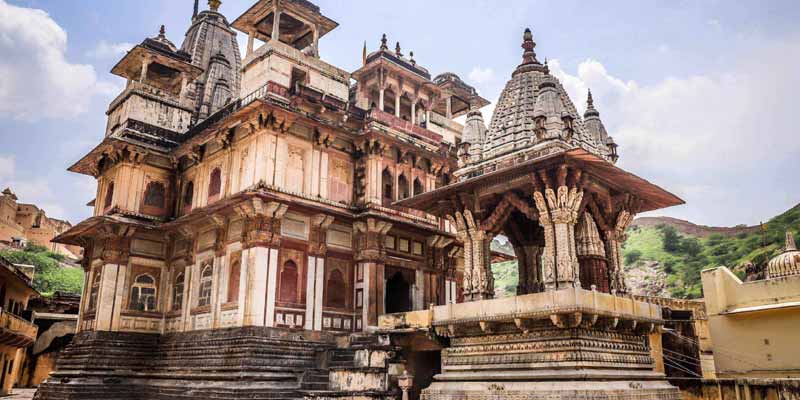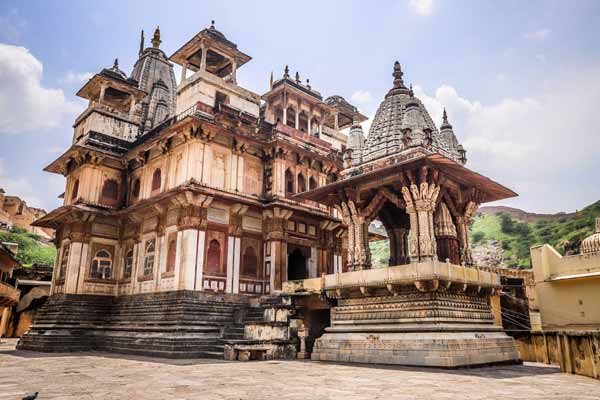Jagat Shiromani Ji Temple Jaipur, located in Jaipur, Rajasthan, India, is a renowned and revered religious site that holds significant cultural and historical importance. Spanning over 250 years, the temple stands as a symbol of architectural brilliance and spiritual devotion, drawing thousands of pilgrims and tourists alike from all over the world.
The temple is dedicated to Lord Krishna, who is worshipped here as Jagat Shiromani Ji. According to legend, the temple was built by Maharaja Sawai Jai Singh II, the founder of Jaipur, in the early 18th century to honor a saintly ascetic named Jagat Shiromani Ji, who resided in this region and was highly revered for his teachings and spiritual wisdom Rajasthan Pilgrimage Tours.
The architecture of the Jagat Shiromani Ji Temple showcases a unique blend of Rajput and Mughal styles, making it a true masterpiece. The intricate marble carvings, delicate jali work, and splendid domes accentuate the temple’s beauty. The main shrine houses an intricately sculpted idol of Lord Krishna, attracting devotees who come to seek blessings, solace, and spiritual fulfillment.
Throughout the year, various festivals and religious events are celebrated with great enthusiasm within the temple premises. Janmashtami, the birth anniversary of Lord Krishna, is celebrated with grandeur, drawing large crowds to witness colorful processions and traditional performances.
Beyond its spiritual significance, the temple is also a prime example of Rajasthan’s rich cultural heritage. It provides visitors with insights into the region’s history, customs, and religious practices. Visitors to the Jagat Shiromani Ji Temple are captivated not only by its divine aura but also by the tranquil and serene atmosphere that envelops the temple grounds. As one enters the premises, a sense of calmness and devotion pervades the air, making it an ideal place for introspection and meditation.
The Jagat Shiromani Ji Temple in Jaipur continues to stand as a testimony to the profound faith and artistic excellence of its creators. With its historical, cultural, and spiritual significance, the temple remains a cherished and revered site, leaving an indelible impression on the hearts of all who come to pay their respects Religious Places in Rajasthan.

History of Jagat Shiromani Ji Temple
The history of the Jagat Shiromani Ji Temple in Jaipur is closely associated with the life of a revered saintly figure named Jagat Shiromani Ji. The temple was built in honor of this spiritual ascetic, and its foundation has roots in the early 18th century.
Jagat Shiromani Ji was a sage who lived in the region around what is now Jaipur during the time of Maharaja Sawai Jai Singh II, the founder of Jaipur and the ruler of the Kachwaha Rajput dynasty. The sage was highly respected for his wisdom, teachings, and devotion to Lord Krishna.
According to the legend, Maharaja Sawai Jai Singh II was once passing by the area where Jagat Shiromani Ji resided, and he was deeply impressed by the sage’s knowledge and spiritual aura. Inspired by the saint’s presence, the Maharaja decided to build a temple in his honor, dedicated to Lord Krishna.
Construction of the Jagat Shiromani Ji Temple began in the early 18th century. The temple’s architecture was influenced by both the Rajput and Mughal styles, showcasing the exquisite craftsmanship of that era. The use of intricately carved marble, delicate jali work (lattice), and splendid domes contributed to the temple’s grandeur and elegance Tourist Places Rajasthan.
The temple’s construction was completed during the reign of Maharaja Sawai Jai Singh II, and since then, it has become a significant place of worship and pilgrimage for devotees of Lord Krishna. The temple’s popularity and spiritual significance have only grown over the centuries, attracting both locals and tourists from far and wide.
Throughout its history, the Jagat Shiromani Ji Temple has witnessed various renovations and restorations, ensuring its preservation and maintenance. The temple continues to hold religious festivals and ceremonies, celebrating important occasions like Janmashtami with great fervor and devotion.
Today, the Jagat Shiromani Ji Temple remains an essential part of Jaipur’s cultural heritage, reflecting the city’s rich history and spiritual traditions. It stands as a testament to the enduring legacy of the saintly sage and continues to inspire visitors with its architectural splendor and spiritual ambiance.
Architecture of Jagat Shiromani Mandir of Amer
The Jagat Shiromani Mandir, located in Amer, near Jaipur, Rajasthan, India, is a magnificent example of architectural brilliance and religious devotion. The temple is dedicated to Lord Krishna and was built in the early 17th century during the reign of Raja Man Singh I, a prominent Rajput ruler.
The architecture of the Jagat Shiromani Mandir exhibits a beautiful blend of Rajput and Mughal styles, showcasing the cultural and artistic diversity of the region. The temple’s design incorporates intricate carvings, exquisite marble work, and elaborate jali (lattice) screens, all of which are characteristic of the Mughal architecture of that era.
The temple’s main entrance is adorned with an intricately carved torana (archway), featuring detailed floral motifs and mythical creatures. As visitors pass through the entrance, they are greeted by a stunning courtyard, which serves as a tranquil and serene space for devotees to offer prayers and meditate.
The sanctum sanctorum (garbhagriha) houses the principal idol of Lord Krishna, which is sculpted from black marble and adorned with intricate jewelry and garments. The idol’s grace and serenity are believed to evoke a sense of spiritual peace and devotion among the devotees.
Another remarkable feature of the temple is its distinct chhatris (elevated pavilions) with ornate domes, which are a prominent element of Rajput architecture. These chhatris surround the main shrine and add to the temple’s grandeur and visual appeal.
The Jagat Shiromani Mandir also features beautiful frescoes and murals on its walls, depicting scenes from Hindu mythology and religious stories. These vibrant paintings contribute to the temple’s visual splendor and narrative charm.
The temple’s domes are a notable aspect of its architecture, and they display a unique craftsmanship that is common in Mughal architecture. The domes are adorned with detailed floral patterns and geometric designs, adding to the temple’s architectural uniqueness.
Overall, the Jagat Shiromani Mandir of Amer stands as a testament to the artistic and religious heritage of Rajasthan. Its architecture is a harmonious fusion of Rajput and Mughal styles, making it an essential landmark in the region and a place of spiritual significance for devotees and visitors alike.
Best time to Visit Jagat Shiromani Ji Temple
The best time to visit the Jagat Shiromani Ji Temple in Jaipur is during the cooler months, which typically fall between October and March. During this period, the weather is pleasant, making it more comfortable to explore the temple and its surroundings.
October to March: This is the winter season in Jaipur when the weather is mild and pleasant. The temperature ranges from around 10°C to 25°C (50°F to 77°F), making it ideal for sightseeing and outdoor activities. The temple grounds are not too hot, allowing visitors to enjoy their visit without the discomfort of extreme heat.
January and February: These are the coolest months in Jaipur, and the temperature can drop to around 5°C (41°F) during the nights. However, the days are still pleasant, making it a perfect time to explore the temple and other attractions in Jaipur.
It is essential to avoid visiting Jaipur during the summer months (April to June) as the temperature can soar to extremely high levels, often crossing 40°C (104°F) or even higher. The scorching heat can make sightseeing uncomfortable, especially when visiting outdoor attractions like temples.
Additionally, the monsoon season (July to September) can bring heavy rainfall and humidity to the region. While the landscape becomes lush and green, the rainy conditions may not be ideal for outdoor activities, and the temple premises can get slippery.
Considering the weather and the overall travel experience, visiting Jagat Shiromani Ji Temple during the cooler months of October to March is the best choice. This will allow you to enjoy the temple’s beauty and spirituality without the discomfort of extreme temperatures.
How to Reach Jagat Shiromani Ji Temple
To reach the Jagat Shiromani Ji Temple in Jaipur, you can follow these directions:
By Air: If you are coming from a distant location or an international destination, the nearest airport to Jaipur is the Jaipur International Airport (IATA: JAI). From the airport, you can hire a taxi or take a pre-paid cab to reach the temple. The airport is well-connected with major cities in India and abroad, making it a convenient option for travelers.
By Train: Jaipur is well-connected to major cities in India by rail. The Jaipur Junction Railway Station is the main railway station in the city. Once you arrive at the railway station, you can hire a taxi, auto-rickshaw, or use ride-hailing apps to reach the Jagat Shiromani Ji Temple. The temple is located at a reasonable distance from the railway station, and the journey should not take too long.
By Road: Jaipur is well-connected to nearby cities and states through a network of national highways and state highways. If you are traveling by road, you can use private vehicles, buses, or hire a taxi to reach the temple. Several intercity and intracity buses operate in Jaipur, and you can find buses that pass near the temple area.
Local Transportation: Once you are in Jaipur, you can use various modes of local transportation to reach the Jagat Shiromani Ji Temple. Auto-rickshaws, cycle-rickshaws, and taxis are readily available throughout the city. Additionally, you can also use ride-hailing apps like Ola or Uber for convenient transportation.
The Jagat Shiromani Ji Temple is located in the city of Jaipur, and many locals are familiar with its location. You can ask for directions from people around you if needed. Additionally, using GPS navigation on your smartphone can also help you find the temple easily.
Remember to check the temple’s visiting hours and any local guidelines or restrictions before planning your visit. Jaipur is a popular tourist destination, and the temple is a significant religious site, so it’s advisable to plan your trip accordingly and enjoy the spiritual and cultural experience it offers.
